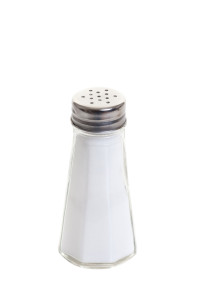 One of the most common problems I see on a daily basis is that patients struggle to limit their salt intake to the 2,000mg per day goal for Pulmonary Hypertension patients. Unlike fluid restrictions where everyone can measure precisely how much fluid they drink, keeping track of salt intake can be very difficult.
One of the most common problems I see on a daily basis is that patients struggle to limit their salt intake to the 2,000mg per day goal for Pulmonary Hypertension patients. Unlike fluid restrictions where everyone can measure precisely how much fluid they drink, keeping track of salt intake can be very difficult.
Let’s start with some basic terms. Salt is the same as sodium chloride. And salt is salt is salt. On a weekly basis, patients ask me if sea salt is better than other types of salt. The answer is no, salt is salt. It does not matter if it is from Hawaii, if it is kosher or if it comes from salt mines in the Himalayas.
One teaspoon of table salt equals 2,300mg of sodium chloride. A pinch of salt is about an eighth of a teaspoon that equals about 300mg of salt. It does not matter if you add the salt while cooking or after cooking, it counts the same.
Where do you find out how much salt is in the foods that you eat?
All packaged food items that you purchase in a store are required to have a nutritional facts section on their packaging. Mid-way down you will find “Sodium” and a number of milligrams. This is the number of milligrams of sodium chloride (or salt) in each serving. For example, a small bag of Lay’s Classic Potato chips has 270mg of sodium. Now let’s consider a can of Progresso Chicken Noodle Soup. Each serving has 690mg of sodium. However, each can has 2 servings. So, if you eat a can of soup you just consumed 1380mg of sodium.
Overall, the biggest problem that I find patients have is that as a culture, we love eating at restaurants. The food is delicious, easy and quick. However, the amount of salt in restaurant prepared food is shocking. Take for example a Big Mac at McDonald’s. There are over a 1,000mg of sodium in a single Big Mac. That does not include the French fries, any added ketchup or mustard or a dessert. If you prefer to dine at the Cheesecake Factory, consider the Thai Lettuce Wraps. One order that serves 2-4 people has 2,347mg of sodium. So if you have one quarter of an order as an appetizer, you just started your meal with about 600mg of salt. Your main course will likely have about twice that. By the end of your meal, you have probably consumed close to 2,000mg of sodium just for dinner.
Unfortunately, even if you try very hard to choose low salt items on the menu, they usually have more salt than you would think. Salads are low in salt, but the salad dressing that makes them delicious is loaded with salt. Grilled fish even has ample salt for “seasoning”. Chefs seem incapable of avoiding a coating of salt on food.
In short, the only way to avoid eating enormous amounts of salt in a day is to cook from scratch and choose your ingredients carefully. Just because you don’t add salt to your food does not mean that your food can’t taste good. You can add herbs and spices to your heart’s content. Fresh garlic and chili can liven up a meal. Allow your guests to salt their food individually.
Beware of the high salt foods that we think of as healthful such as cottage cheese, tomato juice, cold cuts and even breads. Opt for the low salt versions of these. Avoid pickles, olives, and soy sauce. Ditch the saltshaker and embrace fresh herbs.
Salt Substitutes
Lastly, salt substitutes usually contain potassium chloride. For most patients, very small quantities of a salt substitute should not be a problem. However, if your potassium runs high, then even a small amount may pose a risk. It is best to check with your treating physician prior to using a salt substitute.
